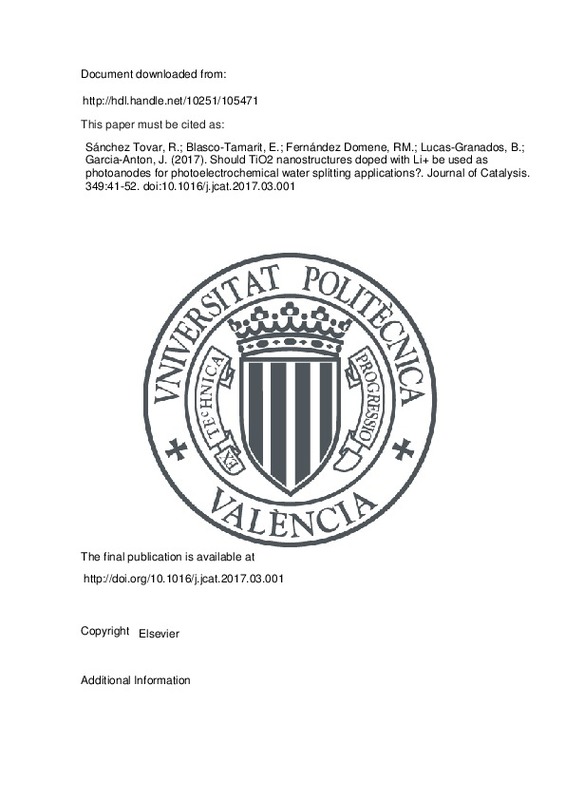JavaScript is disabled for your browser. Some features of this site may not work without it.
Buscar en RiuNet
Listar
Mi cuenta
Estadísticas
Ayuda RiuNet
Admin. UPV
Should TiO2 nanostructures doped with Li+ be used as photoanodes for photoelectrochemical water splitting applications?
Mostrar el registro sencillo del ítem
Ficheros en el ítem
| dc.contributor.author | Sánchez Tovar, Rita
|
es_ES |
| dc.contributor.author | Blasco-Tamarit, E.
|
es_ES |
| dc.contributor.author | Fernández Domene, Ramón Manuel
|
es_ES |
| dc.contributor.author | Lucas-Granados, Bianca
|
es_ES |
| dc.contributor.author | Garcia-Anton, Jose
|
es_ES |
| dc.date.accessioned | 2018-07-07T04:26:24Z | |
| dc.date.available | 2018-07-07T04:26:24Z | |
| dc.date.issued | 2017 | es_ES |
| dc.identifier.issn | 0021-9517 | es_ES |
| dc.identifier.uri | http://hdl.handle.net/10251/105471 | |
| dc.description.abstract | [EN] Different TiO2 nanostructures, nanotubes and nanosponges, were obtained by anodization of Ti under stagnant and hydrodynamic conditions. Samples were doped with Li+ before and after annealing at 450 degrees C during 1 h. The nanostructures were characterized by different microscopy techniques: Field Emission Scanning Electron Microscopy (FE-SEM) and Raman Confocal Laser Microscopy. Additionally, Incident Photon-to-electron Conversion Efficiency (IPCE), photoelectrochemical water splitting and stability measurements were also performed. According to the results, TiO2 nanostructures doped before annealing present the worst photocurrent response, even if compared with undoped samples. On the other hand, this study reveals that Li+-doped TiO2 nanostructures doped after annealing can be used as durable and stable photoanodes for photoelectrochemical water splitting applications. (C) 2017 Elsevier Inc. All rights reserved. | es_ES |
| dc.description.sponsorship | Authors would like to express their gratitude for their financial support to the Generalitat Valenciana (PROMETEOII/2014/009) and to the Ministerio de Economia y Competitividad for its help in the Laser Raman Microscope acquisition (UPOV08-3E-012). | es_ES |
| dc.language | Inglés | es_ES |
| dc.publisher | Elsevier | es_ES |
| dc.relation.ispartof | Journal of Catalysis | es_ES |
| dc.rights | Reconocimiento - No comercial - Sin obra derivada (by-nc-nd) | es_ES |
| dc.subject | Nanostructures | es_ES |
| dc.subject | Titanium dioxide | es_ES |
| dc.subject | Li+ insertion | es_ES |
| dc.subject | Annealing | es_ES |
| dc.subject | Water splitting | es_ES |
| dc.subject.classification | INGENIERIA QUIMICA | es_ES |
| dc.title | Should TiO2 nanostructures doped with Li+ be used as photoanodes for photoelectrochemical water splitting applications? | es_ES |
| dc.type | Artículo | es_ES |
| dc.identifier.doi | 10.1016/j.jcat.2017.03.001 | es_ES |
| dc.relation.projectID | info:eu-repo/grantAgreement/GVA//PROMETEOII%2F2014%2F009/ES/DESARROLLO DE NANOESTRUCTURAS POR ANODIZADO DE TITANIO EN CONDICIONES DINÁMICAS DE FLUJO PARA LA PRODUCCIÓN EFICIENTE DE HIDRÓGENO POR VÍA FOTOELECTROQUÍMICA CON ENERGÍA SOLAR/ | es_ES |
| dc.rights.accessRights | Abierto | es_ES |
| dc.date.embargoEndDate | 2019-05-01 | es_ES |
| dc.contributor.affiliation | Universitat Politècnica de València. Departamento de Ingeniería Química y Nuclear - Departament d'Enginyeria Química i Nuclear | es_ES |
| dc.description.bibliographicCitation | Sánchez Tovar, R.; Blasco-Tamarit, E.; Fernández Domene, RM.; Lucas-Granados, B.; Garcia-Anton, J. (2017). Should TiO2 nanostructures doped with Li+ be used as photoanodes for photoelectrochemical water splitting applications?. Journal of Catalysis. 349:41-52. https://doi.org/10.1016/j.jcat.2017.03.001 | es_ES |
| dc.description.accrualMethod | S | es_ES |
| dc.relation.publisherversion | http://doi.org/10.1016/j.jcat.2017.03.001 | es_ES |
| dc.description.upvformatpinicio | 41 | es_ES |
| dc.description.upvformatpfin | 52 | es_ES |
| dc.type.version | info:eu-repo/semantics/publishedVersion | es_ES |
| dc.description.volume | 349 | es_ES |
| dc.relation.pasarela | S\343041 | es_ES |
| dc.contributor.funder | Generalitat Valenciana | es_ES |







![[Cerrado]](/themes/UPV/images/candado.png)

